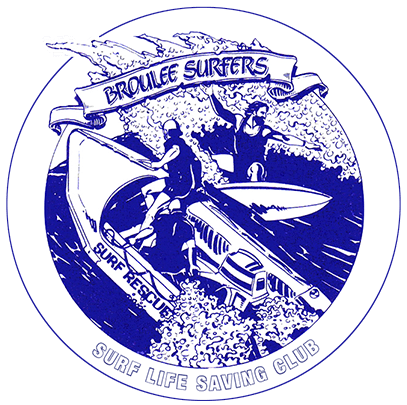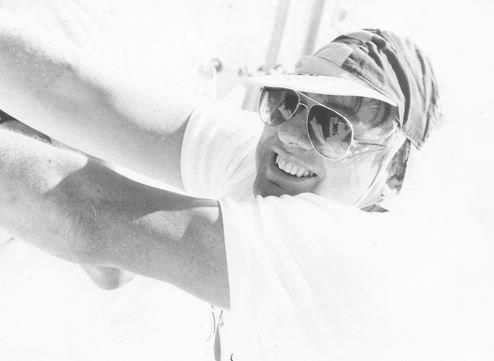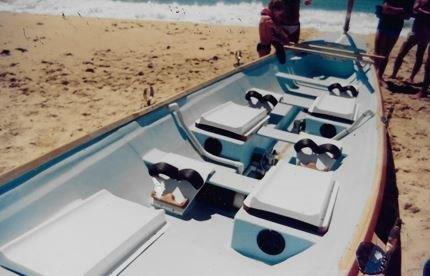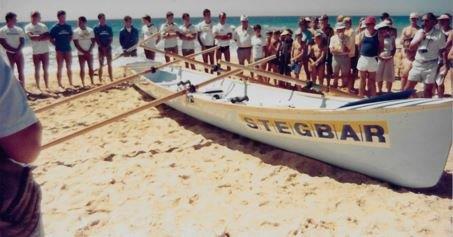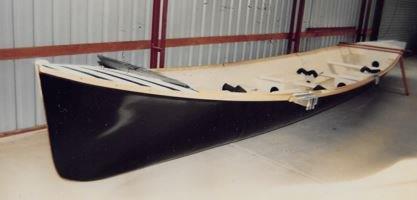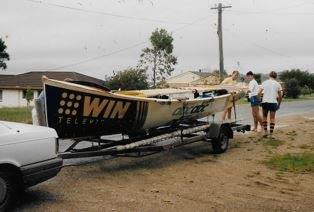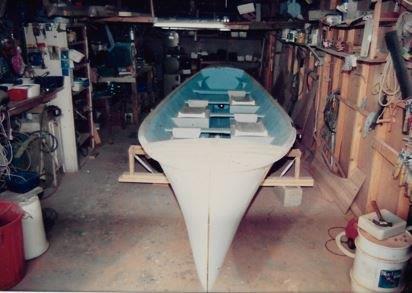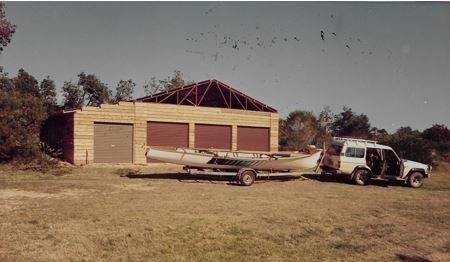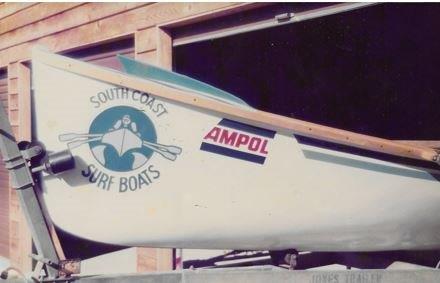The beginning: South Coast surf boat history
As recalled by Gus MacDonald and edited by Gary Pettigrove
South Coast Surf Boats (SCSB) was founded in early 1985 by Graham (Gus) MacDonald. The subsequent owner was Ron Kelly and the company is now owned by Jase Bean.
Gus had a dream to build fibreglass Surfboats that were safer for rowers. He totally innovated the internal fit out of surfboats to make them safer for rowers and safer to race which eventually got SLSA approval.
Gus’ dream was to replace all the wood in the internal fit out for Surfboats with a composite fiberglass inner shell. This fit out would have lots of sealed compartments, creating significant buoyancy which allows surfboats to float above the sea level when full of water and a channel down centre to concentrate water and allow two pumps to remove this water, improve stability and prevent it splashing about as the boat goes through the surf and chop.
The traditional wooden boats had a large manual maintenance requirement that came with them and crews had to sand and revarnish every winter to keep them seaworthy and light. These wooden surfboats had wooden thwarts, wooden knees, curved wooden ribs that protruded towards the centre of the boat where rowers would hit their elbows, legs and stub their toes on the ribs. These wooden surfboats had hollow spaces under the seats and empty bulkheads where rowers could get caught under (especially with their shoulder style life jackets). Every time you caught a large wave, the water would run freely to the front of the boat which made it more difficult for the sweep to steer and hold the boat straight on the wave as the nose went under despite the crew sitting aft.
Gus realised that a Fibreglass Composite surfboat could be built without these protrusions and with sealed bulk heads that filled the under seat and bulkhead spaces would make surf boats safer as there is a lot less space for filling water. These air-filled spaces made it safer for rowers and safer for sweeps and safer for racing crews.
First composite fibreglass boats
The first experience boat builders had with fibreglass in surf boats was a fibreglass external skin overlaying the wooden ply sheets of the Hull and a standard wooden internal fit out. This provided additional strength and improved resilience to the hull but the inside safety issues remained. These fibreglass skin boats were offered by Rodger Ninham. Matt Clymer and Bob Miles. One of the first composite fibreglass surfboats that Ninham built was the “Stegbar 2” which went to Moruya. Rodger then built “Stegbar 3” from wood for Moruya as Rodger felt the wooden boat was better that the Fibreglass mould version he had built. This “Stegbar 3” was a very successful surfboat for Moruya and they won state and Aussie medals in it. It was this wooden “Stegbar 3”, a Ninham built surfboat that Gus used as a model for the plug. From this plug, Gus built the “Red Gelcoat” mould and used this to build the new safer South Coast Surf Boats. This Red Mould is still used by South Coast Surfboats to build new surfboats.
Bob McCelland was a very early adopter to build a fibreglass hull surfboat and with both bulkheads sealed. Gus got to thinking why not have lots of sealed components under all the seats and thwarts and make boats safer. Bob McCelland later obtained the Rodger Ninham “Black Mould” after Rodger passed away. Rodger built the Black Mould to begin his fibreglass composite surfboats. Bob still used wooden thwarts and knees and left the open spaces under the seats in his initial fibreglass and composite surfboats before moving the concept onto the “unsinkable surfboat”. Torquay SLSC had one of the first McClelland boats called the “Dalgety Travel”. It was strong and a great wave boat. Very stable and forgiving for a sweep and a nice banana shaped hull. It was later named after life member “Ron Hussey” who was in the Torquay’s first surfboat crew and a long-time surfboat official. This boat was still be used 20 years later for teaching surf skills work for new crews.
SLSA approvals
Gus needed to have his design approved by the SLSA Boat Panel and for 10 months he attended meetings at SLSA headquarters in Brighton Le Sands. After lengthy discussions with the Boat Panel and the other surfboat builders about specification changes, they approved composite concept and a set of specifications and now surfboats could be made safer for the rowers and better for racing. The SLSA variation to specification that Gus got approved in 1986 was no. 457/86.
It was frustrating initially for Gus that the other boat builders were hesitant about building fully composite boats. Bob Miles was a craftsman who made beautiful wooden boats and at first it was hard for him and the other boat builders to grasp the new composite concepts and it was hard for them to consider significant change. Bob McCelland was the biggest supporter of the composite concept as he did not have a timber boat background and all his boats were composite fibreglass. Gus’ changes were not about ruining other surfboat businesses but making surfboats safer.
During the discussions with the boat panel Gus made a range of models to demonstrate how the composite structures could replace the wooden knees and just be as strong. The wooden knees gave boat its strength and rigidity. The Boat builders were concerned about a knee-less composite boat in a big surf. Removing the wooden knees and using composite fibreglass made surfboats safer for rowers and they were stronger in the surf compared to the traditional wooden boats. Gus also got approval for the channel down the centre and allowed for two pumps to empty the water from the boat before the next wave comes or after clearing the wave area. Gone were the races where we need to carry a bucket.
The outcome of these discussions with the SLSA Boat Panel and the boat builders, saw the new specifications documented and it totally change internal layout of surfboats. Today’s surfboats still follow these build specifications with many sealed compartments providing buoyancy, rigidity, and safer rowing conditions.
The first South Coast surfboat
It was in (1986) for South Coast Surfboats to begin building surfboats from the Red Mould. The construction was fibreglass composite hull and internal shell with wooden gunwales and stainless-steel rowlock holder extensions. Gus would have loved to remove all of the wood from a surf boat but the fibre and foam core technology at the time was not strong enough. It was 6 years later that the technology advancements allowed for the removal of all wood and pioneered by Ron Kelly when he owned South Coast Surf Boats.
Gus built his plug using Stegbar 3 as a model. From plug he built red gel coat mould which is still used today. In early 1980 Bert Hunt went to Rodger Ninham to order a new fibreglass surfboat to replace old Stegbar 2 he had built for them. At the time Rodger said to Bert “look I can build you a much better boat in wood”. So Bert made the order. Gus can remember Rodger at the time made 4 wooden boats the same and they all proved to be very successful. This is why Gus used Stegbar 3 as a model.
The first fibreglass composite South Coast Surfboats by Gus was made in 1986 was a demonstration boat and Ross Jorgensen and crew were the first to row it. Ross knew Rodger Ninham well and liked his shape/style of surfboat. Ross gave his approval of the first South Coast Surfboat. This first boat was purchased by the Felkin Family Caravan Park in Broulee together with Ampol as a sponsor, saw this surfboat go to Broulee Surfers SLSC.
The second South Coast surfboat was built in 1987 for the Moruya SLSC and was named “STEGBAR 4”. The internal boxed fit out is still similar to a new South Coast Surfboats built today.
The South Coast Surfboat came with high sided bench seats so they would be the same height for the rower when they used rolling seats. The rowlocks would still be at same height and these boats had adjustable footrest in both directions to cater for variations in rower’s leg length and heights.
Composite fibreglass is now the norm
The composite fibreglass inner shell was quickly and enthusiastically accepted. The main advantage being the vastly reduced amount of water a boat could take on board when hit by a wave. Together with 2 powerful pumps it was easier to empty the boat before the next wave.
The other boat builders adopted the new fibreglass composite specifications and created their own innovations based on their preferences but still remain within the new fibreglass composite specification. Surfboats were now safer for the rowers, safer in the surf, stronger in rough conditions and rowers no longer need to spend months sanding and revarnishing them over the winter to keep them seaworthy. A good wooden surfboat would usually race for 3 to 4 years in the 1980s before it was replaced with the next new one. Today we see fibreglass composite boats over 10 years old and still going strong at the Aussies. Large improvements in Fibre (glass) technology over the years has improved the life and sustainability of the modern surfboat.
Single skin hulls layup
Initially, the first fiberglass composite surfboats had a foam sandwich hull and a wooden knees and thwarts. The MacKay surfboat from New Zealand (NZ) which came across for the 1988 George Bass with an NZ crew. This NZ boat was left at Broulee Surfers SLSC after the George Bass race. It had a single skin hull and wood internal components which demonstrated its strength and rigidity in all surf conditions. Gus was able to train his crews in this boat and was impressed by how rigid and strong the hull was in all conditions. This spurred Gus further on his innovation journey. This got Gus to thinking about the benefits of single skin hull surfboat. It would never delaminate like the composite foam sandwich boats could, it would never take on water in hull hence maintain its weight and would be more less prone to damage on trailers and rocks.
Nick Dixon requested that Gus make a boat using an NZ boat as a model. This new boat would be given as first prize for the next George Bass Surfboat Marathon which was won by North Cronulla. Gus made plug then mould of the NZ boat. Gus then ran out of time. He was too busy in dentistry. As a favour for Nick, he put mould on the trailer and took the mould to Sydney and got Bob McCelland to lay up the hull and fit it out. Gus brought the finished boat back to the coast for presentation. This boat was found to be more difficult to manage compared to other boats in Aussie waters. No further boats were made from this mould.
The major innovation from this for Gus was how to then successfully replicate its single skin hull design into SCSB.
Start of keel size innovation
When Gus started building surfboats in 1986, the keel started at the bow and ended up a very deep structure aft of stroke foot rest.
Gus knew that sweeping a surfboat was not the same as steering the front of a boat around as in normal craft. For in sweeping a surfboat we are actually flicking back around with sweep oar. Thus the long deep keel acted to against the action of sweeping.
He played with using no keel. This proved difficult to keep the boat straight. Following many experiments, he found a small half moon keel about 1m long and 70mm deep in the centre, positioned under the stroke footrest worked really well. This was the keel Gus fitted to a new Stegbar 4 for Bert Hunt in 1987.
Not only did the smaller keel make the boat easier to sweep, but it also allowed the back of the boat to swing around much faster in a buoy turn. Gus playing with keel design led to other boat builders trying different designs, which eventually led to SLSA changing the keel specification to what we have today, which is a vast reduction in height and length to what was in 1986.
Gus’ reasoning was the smaller the keel, the easier it was to sweep and the safer the surfboat.
Subsequent owners continue the innovation
Gus went on to make approximately 20 surfboats. His last boat was built for Mollymook SLSC, a club with a long and strong history in surfboat racing. South Coast Surfboats was sold in late 1991 to Ron Kelly who was the Mollymook Boat Captain. Ron Kelly continued to build the same style surfboats and was the first surfboat builder in Australia to develop the single skin hull and with foam glass gunwales. Ron Kelly visited Gus to monitor the build of his new Mollymook surfboat on many occasions and made an offer to Gus to buy the South Coast Surfboats business and all current orders. Gus advised Ron to develop the single skin surfboat hull based on the New Zealand boat which he did in 1992. It was time for Gus to pay more attention to his other businesses and his growing family. Gus’ dream of safer surfboats had been fulfilled.
Ron Kelly went to SLSA in 1992 and got approval to build a single skin fibreglass hull. The first single skin hull was built for Bulli and it is their marathon boat which hangs high in the Bulli boatshed.
Ron successfully replaced the wooden gunnels with composite fibreglass, the same technique as all new surfboats today. Ron also purchased the Ninham black mould from Bob McCelland and it has remained with SCSB company assets. Both red and black moulds are available to clubs when purchasing new surfboats from SCSB.
Ron Kelly was the first to build single skin surfboats in 1992 and this single skin style has continued today under Jase Bean. There is no longer any wood included in new surfboats anywhere. The single skin surfboats tend not to put on weight by absorbing water into the hull and they resist damage from trailers and rocks by being more flexible and forgiving. As fibre glass technology rapidly improved allowed Ron Kelly to move to a completely Fibreglass surfboat and no wood was used in surfboats. Ron also added the false floor down to a small pump well area. He progressed this design to a false floor leading to the back of the boat with a flap in the tuck to allow water to drain out.
Ron Kelly sold South Coast Surfboats to Bean Family Company in 2006 and it is now managed by Jase Bean. And Gus’ innovations and traditions continue…..
Since then…
Gus got approval from Paul Schott, the SLSA Boat Panel for a lowered sweep deck on the Clymer boat in 2013. He lowered the decks on an older Whale Beach Clymer and on an Avoca Clymer. The lowering of the stern deck made the Clymer boat easier for sweeps to steer and easier for sweeps to get it in at the start of a race. The sweep rowlock was closer to the water level and easier to manage on a steep wave as the sweep oar handle is significantly lower at the sweep stand. In 2014 Clymer offered this lower stern as a standard option on all his new boats.
Gus’ reasoning was a closer sweep rowlock to water, the easier to sweep, the safer the surfboat. Also, the lower the back deck the easier to jump in, the safer the surfboat.
Gus takes huge pride seeing the surfboats at carnivals along our coast using his innovations in various styles that he fought so hard for in the 1980’s to make surf boats safer.
BROULEE SURFERS
SURF LIFE SAVING CLUB
Heath Street, Broulee NSW 2537
PO Box 5005 Broulee 2537
![]() 02 4471 6657 (Summer weekends)
02 4471 6657 (Summer weekends)![]() [email protected]
[email protected]
